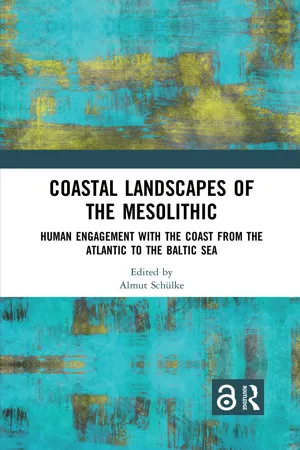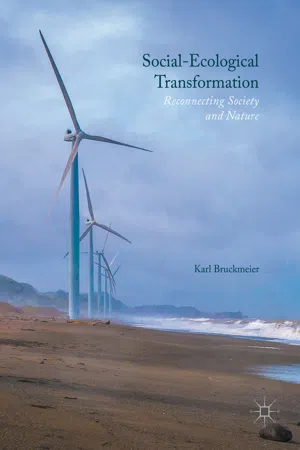Coastal Landscapes
Coastal landscapes refer to the unique physical features and processes found at the interface of land and sea. These landscapes are shaped by a combination of natural forces such as waves, tides, and erosion, as well as human activities. They encompass a diverse range of landforms including beaches, cliffs, dunes, and estuaries, and are important for ecological, recreational, and economic reasons.
5 Key excerpts on "Coastal Landscapes"
- eBook - ePub
Coastal Landscapes of the Mesolithic
Human Engagement with the Coast from the Atlantic to the Baltic Sea
- Almut Schülke, Almut Schülke(Authors)
- 2020(Publication Date)
- Routledge(Publisher)
...As we will see, they create interesting tensions between research landscapes in the different regions. The notion ‘landscape’ is complex, and can have many meanings and connotations (Bender 1993; Thomas 2001; David et al. 2014). It can denote a specific geographic area with specific topographic, climatic, environmental and cultural characteristics in the sense of a surface. Or it can be understood more in the sense of a ‘container’, in which cultural and natural characteristics merge with, for example, human actions, reactions and memories. But it can also be applied to denote a relationship between a contemplator and a subject – in the sense of a (world-)view or a concept of understanding surroundings, comprising humans and non-humans (Thomas 2001; Schülke 2016). Either way, the term ‘landscape’ denotes a ‘section’, either as a spatial section and thus a delimited area, or as a culturally/individually defined understanding of a certain surrounding. In the latter sense, ‘landscape’ applies both to past and present situations and understandings. It encompasses the relationship of people to the coast in the Mesolithic period as well as in our, archaeological, contemporary approaches to it. Thus, the main title of this volume Coastal Landscapes of the Mesolithic serves to address not only the manifold coastal areas that were used by Mesolithic people, but also the different understandings of coastal surroundings in the past, as well as the variety of archaeological approaches to the topic. For archaeologists, the traces and remains that Mesolithic humans left at coastal sites are the main gateway for exploring how prehistoric people might have used, perceived and interacted with coastal areas or ‘landscapes’ in this period. The study of artefacts and ecofacts, with multidisciplinary methods, can give answers to questions such as those addressed in the invitation to the 2016 workshop ‘The Coastal Landscapes of the Mesolithic’ in Oslo (Schülke et al...
- Gerd Masselink, Michael Hughes, Jasper Knight(Authors)
- 2014(Publication Date)
- Routledge(Publisher)
...CHAPTER 1 COASTAL SYSTEMS AIMS This chapter outlines how the coastal zone can be defined and discusses the properties and characteristics of systems, highlighting the importance of sedimentary processes and concepts such as self-organisation. Consideration of systems is useful because it provides a framework by which the dynamic behaviour of geomorphological processes and landforms can be understood. 1.1 Introduction This book is about coastal processes and geomorphology. The spatial boundaries of the coastal zone as considered in this book are defined in Figure 1.1 and follow the definitions set out by Inman and Brush (1973). The upper and lower boundaries correspond to the elevational range over which coastal processes have operated during the Quaternary period, and include the coastal plain, the shoreface and the continental shelf. During the Quaternary (from 2.6 million years ago until present), sea level fluctuated over up to 135 m vertically due to expansion and contraction of ice sheets and warming and cooling of the oceans. The landward limit of the coastal system therefore includes the coastal depositional and marine erosion surfaces formed when sea level was high (at or just above its present-day position) during global warm periods. The lowest sea levels, during global cold periods, placed coastal processes close to the edge of the continental shelf. The seaward limit of the coastal system is therefore defined by the continental shelf break, which typically occurs in water depths of 100–200 m. Changes in global climate during the Quaternary markedly shifted the position of the coastal zone, changing coastal geography particularly in areas with extensive shelves (Case Study 1.1). Many of today’s Coastal Landscapes reflect their Quaternary (and older) geological inheritance, and are responding dynamically to human activity in the coastal zone and ongoing global warming...
- eBook - ePub
- Robert A. Francis, James D.A. Millington, George L.W. Perry, Emily S. Minor, Robert A. Francis, James D.A. Millington, George L.W. Perry, Emily S. Minor(Authors)
- 2021(Publication Date)
- Routledge(Publisher)
...The landscape is deeply rooted in culture and history. It reflects the character and the identity of a tract of land, which gains meaning as a territory for the community that lives there and shaped it. Hence, it is also a social construct, which is reflected in ancient administrative divisions and custom laws (Cosgrove, 2004). As a result, there are multiple interpretations of the landscape, and these will vary between disciplines; for discussions of these different interpretations, and a more specific history of the term, see (for example) Cosgrove and Daniels (1988), Cosgrove (2002, 2004), Olwig (2002, 2004), and Antrop and Van Eetvelde (2017). Given this, it is useful if disciplines, or indeed individual studies, can define as far as possible their interpretation of the term. Table 1.1 gives some definitions of ‘landscape’ from the landscape ecology literature. Two conventional formal definitions of landscape currently exist: (1) that for cultural landscapes, defined by the UNESCO World Heritage Convention (2008, p. 14), which considers cultural landscapes to be the ‘combined works of nature and of man’ and explores various categories and subcategories; and (2) that of the European Landscape Convention by the Council of Europe (2008, p. 9): ‘Landscape means an area, as perceived by people, whose character is the result of the action and interaction of natural and/or human factors’. As most countries are signatories to these conventions, they have had to adopt these definitions in policy; hence, many researchers and practitioners use these definitions so as to apply their knowledge in society. In the context of landscape ecology, there are two main interpretations of the landscape: (1) a spatially delineated physical tract of land ‘with its distinguishing characteristics and features’ (see e.g. Oxford English Dictionary, 2020 and the European Landscape Convention); in this sense, the ‘land’ can be considered a spatial building block in the sense of land units (cf...
- eBook - ePub
- Rattan Lal(Author)
- 2017(Publication Date)
- CRC Press(Publisher)
...Landscape: Classification Philip Schoeneberger U.S. Department of Agriculture—Natural Resources Conservation Service (USDA-NRCS), Lincoln, Nebraska, U.S.A. Abstract The earth’s surface is not uniform, but it can be understood and consistently described. It is a universal human activity to evaluate and categorize the earth’s surface into groupings useful for management decisions. The most robust and versatile classification schemes include attributes that capture the surficial form, internal composition, spatial arrangement and distribution, with attention to how these parameters affect vegetation and land management options. Geomorphology provides a framework that integrates these parameters to describe the inherent architecture upon which natural systems and processes operate. INTRODUCTION Groups of spatially associated landforms that share common forms, patterns, composition, or site history are called landscapes. Landscapes are a general and convenient way to summarize the context or setting of a land area. Identifying various landscapes and placing them into an orderly array constitute landscape classification. Project purpose and scale (minimum polygon size) determine the most appropriate approach to landscape classification. Landscapes The word landscape is widely used in at least three different ways, all of which are legitimate and can be readily found in soil-related literature: 1. Informal context : Landscape—a portion of land that the eye can comprehend in a single view. [ 1 ] This “everyday” context refers to whatever portion of the earth’s surface that surrounds you or whatever you can see outside your window (Fig. 1). It is utterly dependent upon where you happen to be standing. There is a huge difference between “what the eye can comprehend” (see) from a mountain top vs. the view from a coastal plain marsh. This perspective depends exclusively upon your field of view...
- eBook - ePub
Social-Ecological Transformation
Reconnecting Society and Nature
- Karl Bruckmeier(Author)
- 2016(Publication Date)
- Palgrave Macmillan(Publisher)
...A paradigmatic case is the Bay of Bengal in South Asia, the largest bay of the world, where the densely populated coasts are the home of about 40 % of the global population, mainly poor. This coast and the inhabitants are highly vulnerable to climate change (Samarakoon 2004). As a consequence of climate change, the management of coastal resources need to be rethought; this requires the integration of the perspectives of resilience and sustainability. Weinstein et al. (2007 : 43) describe the challenges of sustainable coastal management in the twenty-first century as sharing of space and resources between humans and other species, as conflict mitigation, consensus building, sacrifice, and compromise. In some regards, the situation in coastal areas is similar in all countries. Coastal Landscapes are the preferred human habitats; two-thirds of all megacities are located at the coast. The global economy, global transport, and communication are strongly dependent on coastal cities and ports. In all continents, the population in coastal areas increases. Duxbury and Dickinson (2007 : 319) describe the situation demographically: approximately 41 % of the world’s population is living not more than 100 kilometres away from the coast: in 1990, 2 billion people and in 2000, 2.3 billion people. In 2025, the number is expected to be 3.1 billion people (Duxbury and Dickinson 2007 : 319). Because of the concentration of natural resources in coastal waters, the coastal ecosystems are important as life-supporting systems. Ecologically seen, coastal areas are vulnerable to climate change and sea level rise, storms, floods, earthquakes, and tsunamis. People continue to move to the coasts, although disasters increase and the impacts of climate change and sea level rise can already be experienced. After the devastation of New Orleans through Hurricane Katrina in August 2005, people moved back in the city and continued to live as usual...




